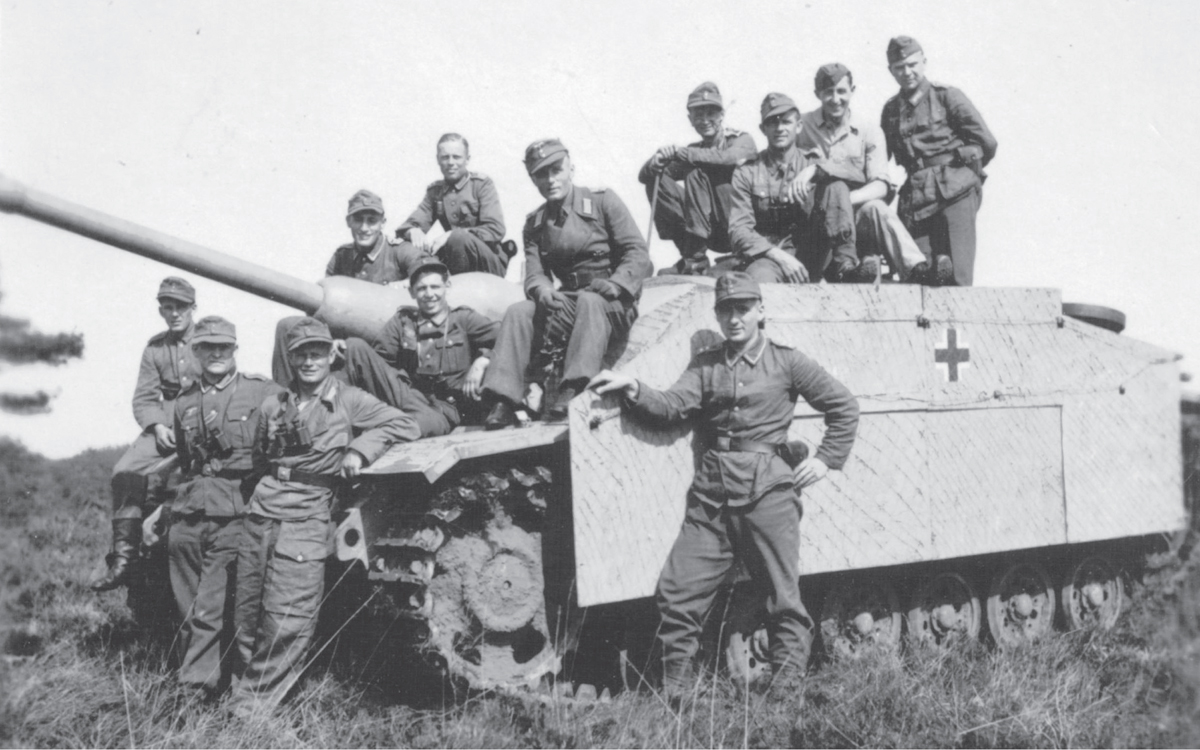
It appears that the crew of this Sturmgeschütz has applied Zimmerit to the Seitenschürzen (side skirts). Why would they do this? To author’s knowledge no army used magnetic anti-tank hollow charges in the war. (Anderson)
7 ‘neuses Sturmgeschütz’ in 1945
During the final phase of World War II the number of important Sturmgeschütz in service with German armed forces increased dramatically.
The first Sturmgeschütz entered production in 1940 and was initially manufactured only by Altmärkische Kettenfabrik GmbH (Alkett) at Spandau (assembly) and Falkensee (chassis). As demand increased, Mühlenbau und Industrie AG (MIAG) at Amme Werk, Brunswick began production in 1943, and monthly output grew from 130 in January to 400 in October 1940.
An improved Sturmgeschütz
Due to several reasons, the tactical value of the Sturmgeschütz was seen as so important that a new weapon was developed – the Jagdpanzer. By 1942, both the military and political leadership had realized the seriousness of the supply situation. At the same time, a re-evaluation of German tank design began, which added to the already considerable amount of uncertainty. New types were conceived, developed and finally rushed into production without a preceding and extremely important trials phase. The main development was a massive increase in armour protection and sloped armour as used for the new PzKpfw V Panther medium tank.
The aim, at all levels, was to achieve an increase in combat power. In early 1943 work began on a new type of assault gun, for which the latest requirements were naturally adopted. The ‘neues Sturmgeschütz’ would have the following characteristics:
•A high level of armour protection: Sloping armour plates of 60mm (later increased to 80mm) at the front, and sloping 40mm armour for the sides.
•A more powerful main gun: 7.5cm KwK 40 L/48, later replaced by the 7.5cm KwK 42 L/70.
•Improved self-defence: Front-firing port for a Maschinengewehr (MG) 34 and the installation of a short-lived Rundumfeuer-Maschinengewehr (all-round fire machine gun), and a Nahverteidigungswaffe (close-support weapon), which were never delivered in sufficient quantities.

It appears that the crew of this Sturmgeschütz has applied Zimmerit to the Seitenschürzen (side skirts). Why would they do this? To author’s knowledge no army used magnetic anti-tank hollow charges in the war. (Anderson)
Vogtländische Maschinenfabrik AG (VOMAG), which had been producing the PzKpfw IV tank since the end of 1941, was contracted to design, developed and produced this promising vehicle. In May 1944, all production was converted to the new leichte Panzerjäger IV, to be superseded a few months later by the Panzer IV/70 (V).
During development it was planned to eradicate the known shortcomings of the original Sturmgeschütz. However, this was only partially achieved. Whatever improvements were implemented, most were negated by the decision to fit the vehicle with unmodified PzKpfw IV suspension originally designed for a 17-ton tank. However, the Panzer IV/70 (V) weighed 26t due to it having 80mm frontal armour and mounting the powerful (and heavy) 7.5cm KwK 42 L/70 gun. The vehicle was dangerously overweight causing the chassis, suspension and the running gear to be over-stressed. The ‘ultimate’ new assault gun proved to be nose-heavy and almost impossible to steer over soft ground.
Yet another ‘new’ Sturmgeschütz arrived in April 1944 when BMM/Škoda delivered their PzJg 38 (Hetzer – Baiter) based on the chassis of the PzKpfw 38(t).
To make up for the loss of production caused by Allied bombing it was decided, in January 1944, to produce the StuG IV. This was technically almost identical to the StuG III and was to be built by Krupp-Grusonwerk at Magdeburg, replacing PzKpfw IV production.
However, despite the fact that production of the type’s successor had actually started, it was virtually impossible to terminate production of the old type of Sturmgeschütz in favour of the new type, as Adolf Hitler had demanded during a meeting on 20 April 1944. Both the StuG III (SdKfz 142) and StuG IV (SdKfz 167) would remain in production until end of the war.
The Nibelungenwerk in St Valentin, Austria now remained the only company manufacturing the PzKpfw IV, and production was increased temporarily to 300 units a month.
| StuG III Alkett, MIAG | StuG IV Krupp-Grusonwerk | |||
| 1943 | 3,215 | |||
| 1944 | 4,743 | 1,006 | ||
| 1945 | 1,055 | 105 | ||
| Totals | 9,013 | 1,111 | ||
The true importance of the ‘old’ Sturmgeschütz (and all the different Jagdpanzers based on this concept) for the German war machine becomes apparent by examining the production figures for the last months of the war. The total of Alkett and MIAG-produced ‘old’ Sturmgeschütz is approximately the same as that for all other tanks. Moreover, if the assault gun-armed Panzerjäger are added, the proportion grows to 2.6 to 1.

December 1944: US troops inspect an immobilized Sturmgeschütz of an unidentified unit in the town of Obergeich near Koln (Cologne). (NARA)
The conversion of the Panzerwaffe to modern equipment had finally failed.

(Figures taken from: Panzer Production (Jentz) and the website Panther 1944.)

A Sturmgeschütz III Ausf G mounting a 10.5cm Sturmhaubitze 42 (StuH – assault howitzer) on the firing range during trials. Note the non-standard search light mounted on the roof of the superstructure, which suggests that the vehicle is in 7.SS Freiw GebDiv Prinz Eugen. (Anderson)
StuG in Non-Artillery Use
As noted earlier, the decision to deliver some of the Sturmgeschütz produced to services other than the Heeres-Artillerie was sensible, particularly after the latest disaster at Stalingrad. In conclusion:
•Sturmgeschütz were used to reinforce the tank destroyer elements of Luftwaffe-Feldeinheiten and later, infantry and mountain divisions.
•For the establishment of PzStuGAbt in PzGrenDiv.
•Finally to compensate for missing tanks in the Panzer divisions.
The reason for the slow conversion process dates back to the time when the Soviet T-34 and KV tanks were first encountered in 1941.
While the tank force quickly learned how to fight this threat, partly by tactical skills, and partly by much better leadership, all other units remained in desperate need of better weapons.
Widening the range of Sturmgeschütz duties was a logical step; in 1942 the type had proven its effectiveness and was highly appreciated by the fighting troops. However, the actual combat value of the Sturmgeschütz depended on how the type was deployed, the overall competence of commanders, the equipment situation at the mother unit and the efficiency of the supply chain.
Even in late 1944 on the Ostfront (Eastern Front), a certain level of tactical superiority was still being maintained. However, this superiority was limited to only small-scale deployments. Faced by the Soviet numerical superiority on the ground, the massive artillery bombardment before any large (or even small) attack, followed by ground-attack aircraft, German commanders realized that defeat could only be delayed. Taking a broader view, German forces had made rapid advances on many battlefronts and achieved most of their objectives, but had become dangerously overstretched. As a consequence of the above, the Ostheer (Army East) had been forced to begin a slow withdrawal in 1944.
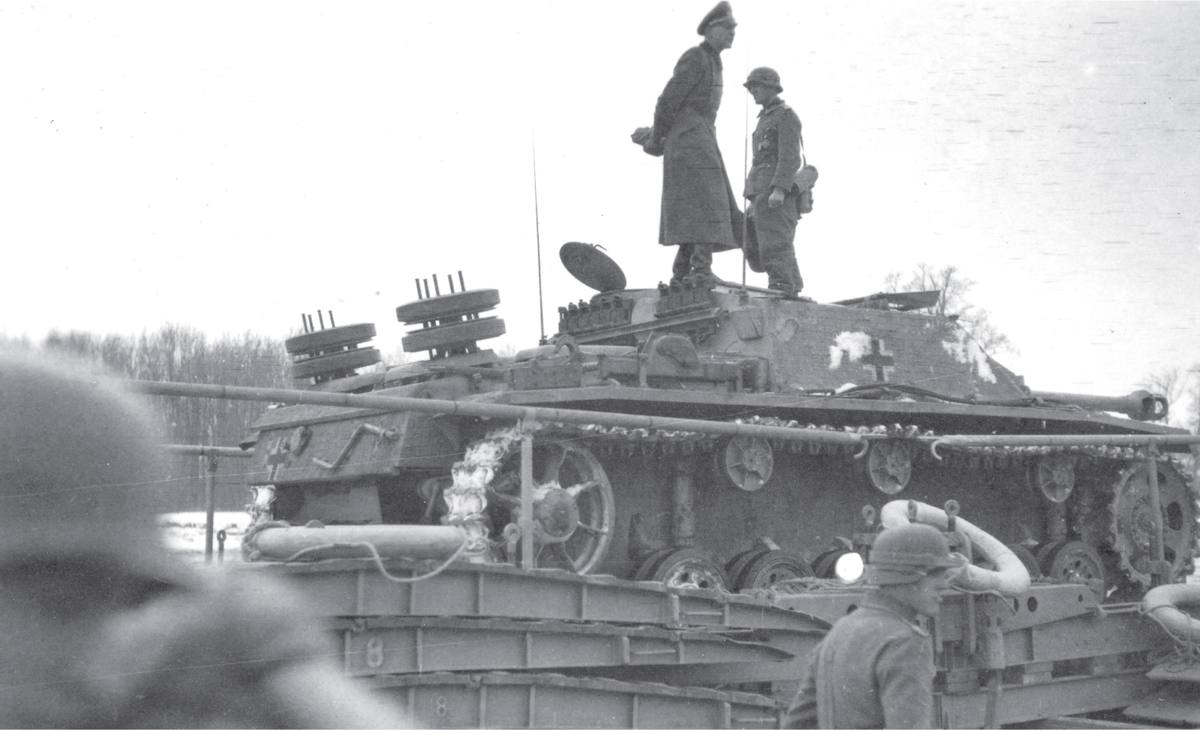
A MIAG-built Sturmgeschütz is a transported over a river on a ferry assembled from pontoons by field engineers. Note spare track pins have been placed into the spare road wheel mounted on the rear. (Anderson)
A rare example of an after-action report from Sturmgeschütz issued to a PzJgKp of an unknown infantry division in the east was published in the January 1945 issue of Nachrichtenblatt der Panzertruppe:
Experiences of a StuGKp with fighting the Josef Stalin tank:
The company had the mission of holding an important village in cooperation with the divisional reconnaissance battalion. After the Bolsheviks failed three times to take the place, they decided to set up an attack after very heavy preparatory bombardment. The fourth attack was launched, supported by two Josef Stalin [JS] and their four remaining T-34s. The enemy tanks made best use of heavy smoke from the burning village blowing over our front line. When the smoke cleared, the tanks (the JS in the lead) were at in 300m to 400m distance among some destroyed tanks, opposite our Sturmgeschütz. When they lost the cover of smoke, they turned and retreated. During this manoeuvre, all were knocked-out within 20 minutes, one JS by a clear penetration on the left-hand side of the turret, the other by a hit on the rear armour of the turret below the machine gun port.
The next day the Russians attacked only with infantry, but positioned two JS at 2,000m distance, providing fire support for the infantry. The attack was repulsed; our Sturmgeschütz had no losses since they constantly changed position.
At dawn the next day, the Russians attacked with three JS, carrying infantry, from the northern flank without any artillery support.
Since the JS had been spotted early enough, the company was regrouped in a way that the tanks would inevitably run in a Feuersack (fire sack [trap]). The company had at this time six Sturmgeschütz: Two were used to lure the JS into the trap and four were positioned in the flanks to open fire at the ideal range. The attack of the three JS was aimed at the centre of the village, where the two centrally positioned Sturmgeschütz waited in their positions. At a range of 300m an anti-tank gun of the reconnaissance battalion opened fire. A direct hit on the front of the JS was achieved, but did not penetrate. However, the crew, abandoned their tank immediately. One Sturmgeschütz moved into a better position to get clear field of fire. Its first round hit the tank, blasting off the commander’s cupola of the abandoned tank, which then burst into flames. The remaining JS turned without opening fire. After nightfall they moved again into position some 700m away from the northern of the village and opened fire on our anti-tank gun positions. In this situation they were attacked from the left flank by two Sturmgeschütz from a favourable range (600m). After being hit by four shells, one penetrated the side of the turret and the JS caught fire. The tank burnt out completely; the crew did not escape. The crew of the second JS abandoned their tank after the first hit, which did not penetrate. With three further rounds, of which one penetrated the side of the turret, the abandoned tank caught fire and finally exploded.
In these few days the company, which held the village with six Sturmgeschütz, destroyed nine T-34 and five JS without loss. Proof of that it is possible to destroy the JS by fire from the 7.5cm StuK 40 with PzGr 39 at ranges of up to 700m. That will need only good nerves, a cool head and a correct tactical deployment.
During the combat it became obvious that the JS catches fire as easily as the T-34. In rough terrain, the JS lacks the mobility and agility of a T-34, so that it can be attacked and destroyed by two Sturmgeschütz with well-trained and aware crews. It is important to change position after two or three rounds are fired. The JS has a low rate of fire that should be always exploited.

Sturmgeschütz in the last winter of the war: All three are packed with ‘riding’ infantry; the first appears to be towing the following vehicle, although this was officially forbidden. However, units regularly ignored the order, as every Sturmgeschütz was regarded as precious and recovery was (when possible) essential. (Getty)

Two Sturmgeschütz move up through a village at the Ostfront (Eastern Front) in 1943: Only the first one is fitted with side skirts; the German military attempted to deliver these items to all front-line Sturmgeschütz and Panzer units before Unternehmen Zitadelle (Operation Citadel), but failed. (Getty)
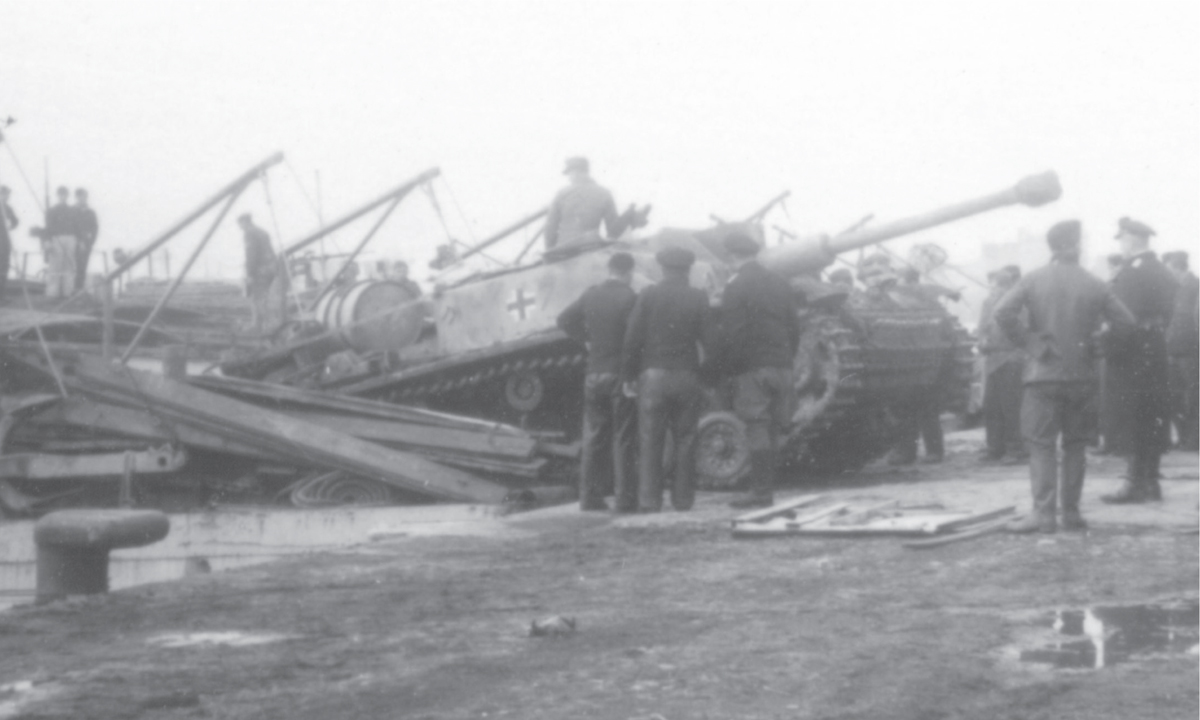
A Sturmgeschütz Ausf G being disembarked from a Marinefahrprähm sea-going lighter. Images of other units using ferry transport show that the Seitenschürzen (side skirts) were removed before loading. (Hoppe)
The bureau of the Generalinspekteur of the Panzertruppe gave a telling comment:
The success of this StuGKp again shows that the Josef Stalin, the heaviest Russian tank, can be defeated by the 7.5cm L/48 gun. The prerequisites for a successful attack are thorough camouflage, best possible usage of the terrain, and hit-and-run style deployment at favourable combat range.
These remarks show how far some officials were from reality in 1945, although the successful combat by this un-named infantry division shows that it was possible to defeat even the mighty JS-2 heavy tank by tactical planning and careful deployment. In France after the invasion, German forces had to face a different opponent whose massive army was well equipped with modern armour, anti-tank weapons and which was tactically well organized. Air superiority, which halted any movement by German forces, which was also used to attack road convoys and railway trains carrying supplies to the front.
The few Sturmgeschütz attached to the infantry divisions were not able to withstand the power of the Allied advance.
When attached to a tank division, the basic design of the StuG made any effective combat against a well-trained enemy force a difficult task.
The table ‘StuG lage 2 February 1945’ was published by the Quartermaster General to show the number of Sturmgeschütz operational within all (except Sturmartillerie) German units. The list also contains some interesting detail:
•Even in 1945, not all infantry divisions had been reformed with a ‘new style’ PzJgAbt.
•Some units were equipped with Sturmhaubitze.
•A small number of 7.5cm KwK L/24 and L/43-armed StuG remained in service.
•Units deployed in Italy and the Balkans had to use Italian-built Semovente (self-propelled guns).
•Some battle-worn units only had the status of a Kampfgruppe (KpfGr – battle group).
•Even a small number of PzKpfw II light tanks had been issued to a few units.

These German soldiers give scale to the low height of the Sturmgeschütz. Although normally deployed in the offensive role, if it was carefully dug in hull-down it would be virtually invisible and ready for a deadly ambush. This StuG Ausf G was produced after August 1944 is fitted with the Saukopf (pig’s head) mantlet and no factory-applied Zimmerit. (Anderson)

A Sturmgeschütz and a column of Borgward B IV Ausf B Ladungträger (demolition charge carriers) from Panzer Versuchs-und Ersatzabteilung (PzVersAbt – experimental and replacement battalion) 300(Fkl): The StuG is possibly an experimental Leitpanzer (control tank), but the additional aerial for the radio-control equipment is not fitted. (Anderson)
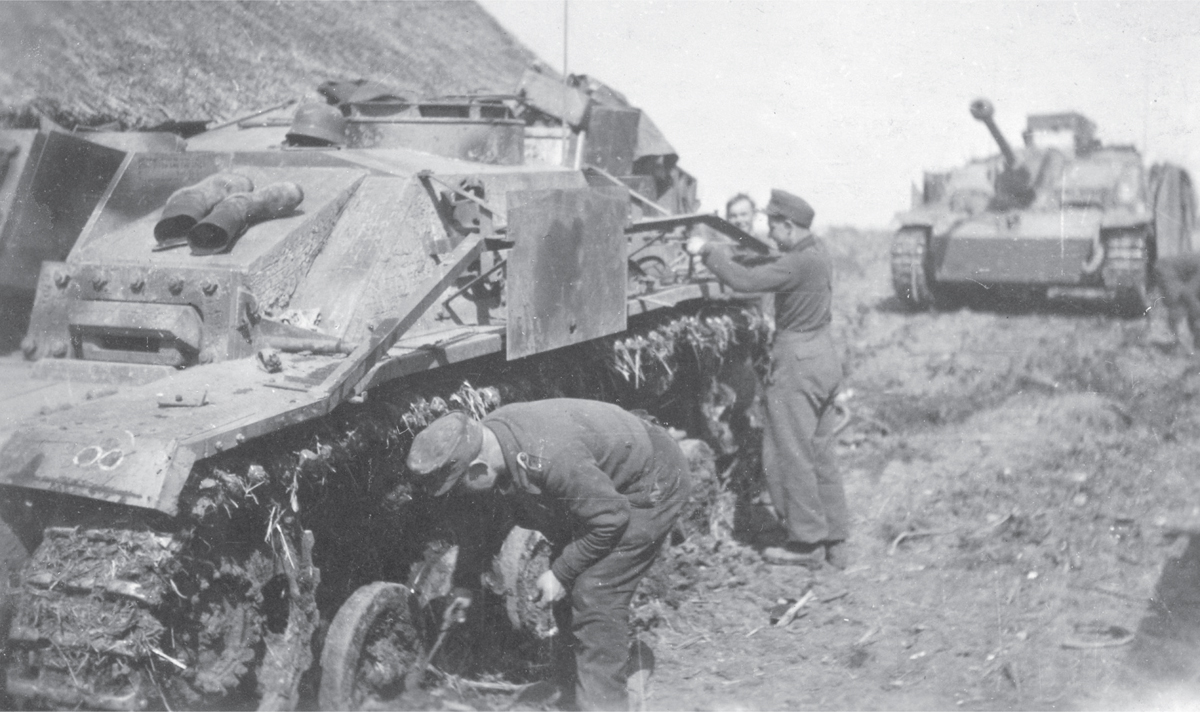
It was essential to remove all the mud and other debris from the running gear on a Sturmgeschütz. All moving parts required periodic lubrication, but the oil in the transmission and engine had to be changed regularly. Note that the crew had improved the mounting brackets for the side skirts by welding on a section of angle steel. (Anderson)
In August 1944, 14.PzDiv with PzRgt 36 was re-equipped after its deployment to Bessarabia (Moldova and Ukraine). According to an August 1944 strength report, the unit was authorized to have a PzStuGAbt (III.Abt/PzRgt 36) with 44 Sturmgeschütz, and also 21 PzKpfw IIIs and 54 PzKpfw IVs forming a II.Abt. After being issued with PzKpfw V Panther medium tanks in France, I.Abt/PzRgt 36 was immediately transferred to the Kurland (Courland) peninsula in Latvia to support German forces involved in heavy fighting against the Red Army which was determined to overrun the area.
6.Abt/PzRgt 36
Combat report dated 12 October 1944
Attached to I.Abt/GrRgt 23
Course of the fighting:
Shortly after 06:00hrs the enemy attacked on both tracks from the south towards Skuodas [Lithuania]. The company moved into position in the western part of Skuodas with two Sturmgeschütz. After a Russian infantry attack was repelled, at 08:30hrs three JS and five assault guns advanced to support the infantry in the southern part of Skuodas. Three JS and four assault guns were destroyed; the remaining assault guns turned and retreated. The company remained to safeguard the positions. While moving into new positions we destroyed an anti-tank gun. At 16.30hrs two further assault guns were reported to be advancing on Skuodas. When the company arrived, one had already been destroyed by our anti-tank guns; the other was then destroyed by a Sturmgeschütz of the company. In the following hours, our positions were hit by heavy fire from artillery, anti-tank guns, tanks and mortars.
| Daily report: | combat ready: | Two StuG |
| under repair within 14 days: | Five StuG | |
| under repair over 14 days: | One StuG | |
| Losses: | None | |
| Enemy losses: | Three JS | |
| Five Assault guns | ||
| One Anti-tank gun |

Soviet soldiers leave their US-built GMC truck to inspect a knocked-out Sturmgeschütz. The crew had applied concrete to the front of the superstructure, but it appears that this StuG has received a direct hit which has blown the roof off of the fighting compartment. (Anderson)
This stunning combat success was achieved with only two operational Sturmgeschütz. Other documents show that commitments such as this were not the exception; German losses were always disproportionately lower than those of the Soviets. However, the equipment situation in PzRgt 36 was critical, and by November 1944, II.Abt/PzRgt 36 reported that it had a mixed establishment of only a few tanks. This was quite usual for Panzer divisions in the east; many infantry and Volksgrenadier units involved in the fighting had an even worse establishment of armoured vehicles and heavy anti-tank weapons. The war reached its bitter end.
| II./PzRgt 36 13 October 1944 | PzKpfw IV (lang) | StuG | PzKpfw III | Flakvierling |
| Combat ready | 5 | 3 | 1 | 3 |
| Short-term repair | 12 | 2 | 1 | – |
| Long-term repair | 4 | 1 | – | – |
| Total losses | 15 | 5 | 1 | – |

Effectively camouflaged with whitewash, a Sturmgeschütz Ausf G travels along a narrow track in a snow-covered forest. The vehicle has Seitenschürzen (side skirts) and two spare road wheels are carried on the track guard. Note that the vehicle is fitted with smoke candle dischargers. (Anderson)
PzJgAbt 4 of 32.InfDiv
For infantry forces without integrated mobile armour such as tanks, the requirement for an effective mobile anti-tank defence was essential. Although this was recognized early it became crucial during the fighting in the east between 1943 and 1944.
When winter arrived in 1944, 32.InfDiv had an integrated StuGKp with ten Sturmgeschütz and was part of the German force defending East Prussia. On 2 December 1944, 32.InfDiv submitted an after-action report detailing their experiences of the second Battle of Kurland:
Experiences:
Enemy
1.) Before the assault
We noticed that the enemy launched very strong reconnaissance missions before his main attack. From 19 to 21 November he launched heavy assaults with limited objectives, supported by combined preparatory artillery bombardment and tank charges, in order to gain favourable starting points for the commitment of his main tank force. For us, these preparatory assaults had an advantage – the enemy could not disguise of his intentions. Subsequently the enemy suffered heavy losses. Furthermore we were able to take prisoners.
Enemy propaganda units started to free German POWs after showing them his large arsenal of heavy weapons and tanks, in order to demoralize our troops. This attempt failed.
2.) During the major offensive
Because of the unfavourable terrain and weather conditions, the enemy could neither commit his superior air force nor deploy his tank units to full extent. The enemy tried to compensate for the lack of these forces by keeping up an intense bombardment from artillery of all calibres.
Despite this heavy barrage, enemy infantry could only gain success at places where our infantry had been virtually wiped out. Even surviving machine-gun crew was able to deter a number of massive infantry assaults. A number of counterattacks led by an energetic officer with a few brave men and Sturmgeschütz have repeatedly repelled away strong enemy battalions. Our night attacks, even in moonless conditions, proved to be most effective. The Russians ran in fear from our advancing men, who were shouting “Huzzah”, and firing their Sturmgewehr [MP44] from the hip.
3.) The enemy’s peculiarities
a) Infantry
Enemy infantry was, despite constant replenishment, poorly trained. They were never encouraged forward during an assault, and as soon as they met stiff resistance they always retreated.
Exception: The Russian punishment battalions: The troops of these units see their only chance for parole to take part in valiant combat. Any appearance by our Sturmgeschütz or tanks impressed the enemy in such a way that every attack collapsed; whereas our counterattacks supported by armour usually succeeded.
c) Tanks
Even if the operational deployment of the enemy’s tank forces was impeded by the terrain, smaller Panzerrudel (pack of tanks) were used at points of main effort to support an infantry attack. It was noticeable that the Russian tanks still have better mobility than ours. The impact of their tank guns was powerful enough to destroy our heavy tanks (Tiger). However, when they suffered their first losses to our anti-tank defences, they quickly became discouraged and retreated to fire their weapons from longer range.
d) The Russian commanders proved to be unable to exploit any initial success.
Own forces:
1.) Infantry
The performance of our infantry was exemplary despite being under constant attack and suffering almost total exhaustion. Officers and the few remaining proven senior NCOs were at the heart of our resistance.
3.) Anti-tank defence
The backbone of our anti-tank defence were the mobile tank destroyers (Sturmgeschütz and Panzer), and close-combat anti-tank weapons. The PaK mot Z (towed anti-tank guns) of the PzJgAbt could be only used as infantry strongpoints. Organization of the anti-tank defence by the divisional Stabsoffizier für die Panzerbekämpfung (Stopak – staff officer anti-tank defence) proved effective. Defensively the Sturmgeschütz and Tiger tanks proved to be a success, but their mechanical vulnerability remained a constant problem. The commander could only rely on a third of these vehicles being operational.
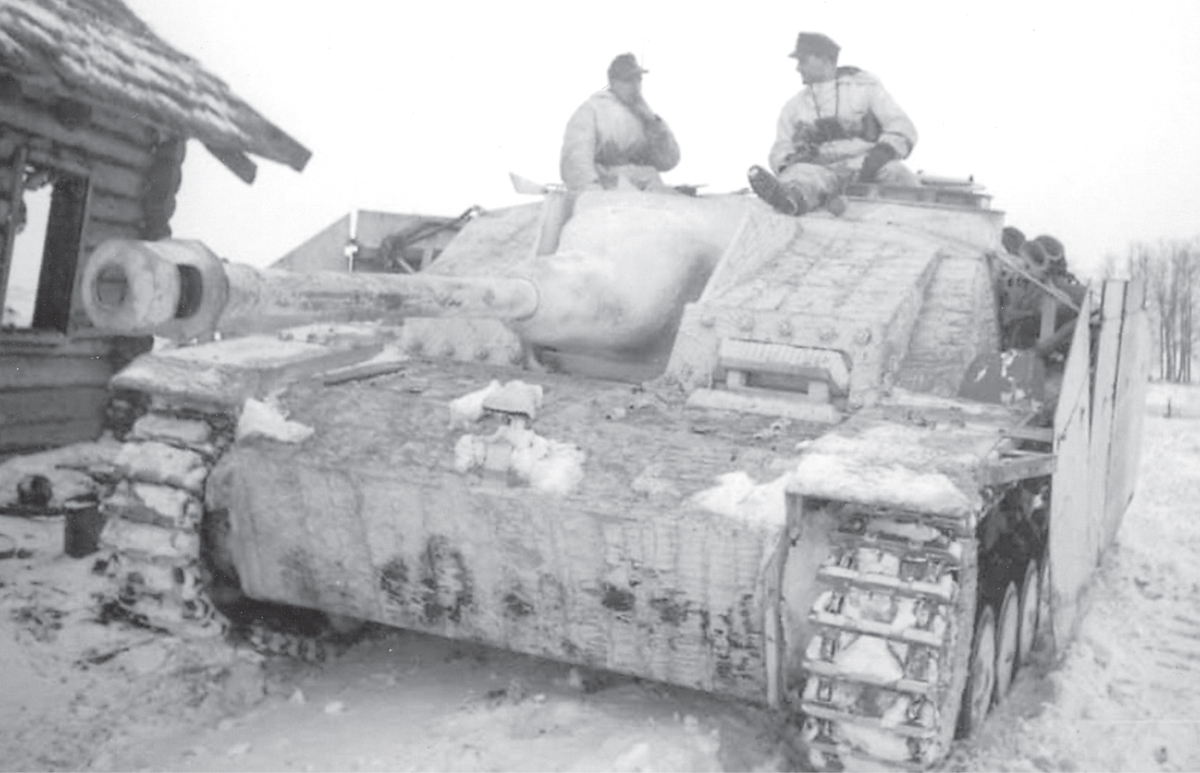
The crews knew about the problems with the side skirt mountings, so many units tried to convert and improve them using their own means. This particular vehicle received a small deflector in front of the first plate. (Anderson)
Theoretical structure of Grenadierregiment 4 in the depth of the battlefield, showing position of PzJg (StuG) Kp 4

The rubber tires, especially those of the inner road wheels, wear out often. In most cases loosening of the bonding.
It is interesting to note that the Sturmgeschütz, despite their many shortcomings, were still being rated as successful even in late 1944. The reduction of the well-armed PzKpfw VI Tiger heavy tank to a ‘mobile anti-tank weapon’ is telling, but understandable due to the special circumstances of the Kurland battlefront. The outcome of the second battle for Kurland was decisively influenced by the terrain and the weather. Despite having a great numerical superiority, and unlimited supplies the Soviets proved to be unable to decisively defeat the German forces after fighting six battles.
It is true that in late 1944 the Red Army had concentrated its forces in the central and southern sector of the battlefront and was steadily advancing on Berlin and other centres of power. To a certain degree, Kurland was regarded as being a secondary battlefront. However, the number of Soviet forces being concentrated on the Baltic front was far superior to the fragmented units which made up the trapped Heeresgruppe Kurland. German forces held their positions on the peninsula until the Third Reich surrendered on 8 May 1945.

Königsberg in 1945: A Russian soldier walks down a path cleared through equipment abandoned by a German armoured anti-tank battalion. To the right are the wrecks of two StuG IVs; the StuG III Ausf G (left) has been fitted with improvised side skirts. The Bergepanzer III in the background has been fitted with an armour plate with a slot for a light weapon, possibly an antitank rifle. (Anderson)
Sturmgeschützlage by 2 February 1945
All army groups, no Sturmartillerie units, operational vehicles only

tbd: to be delivered.

tbd: to be delivered.

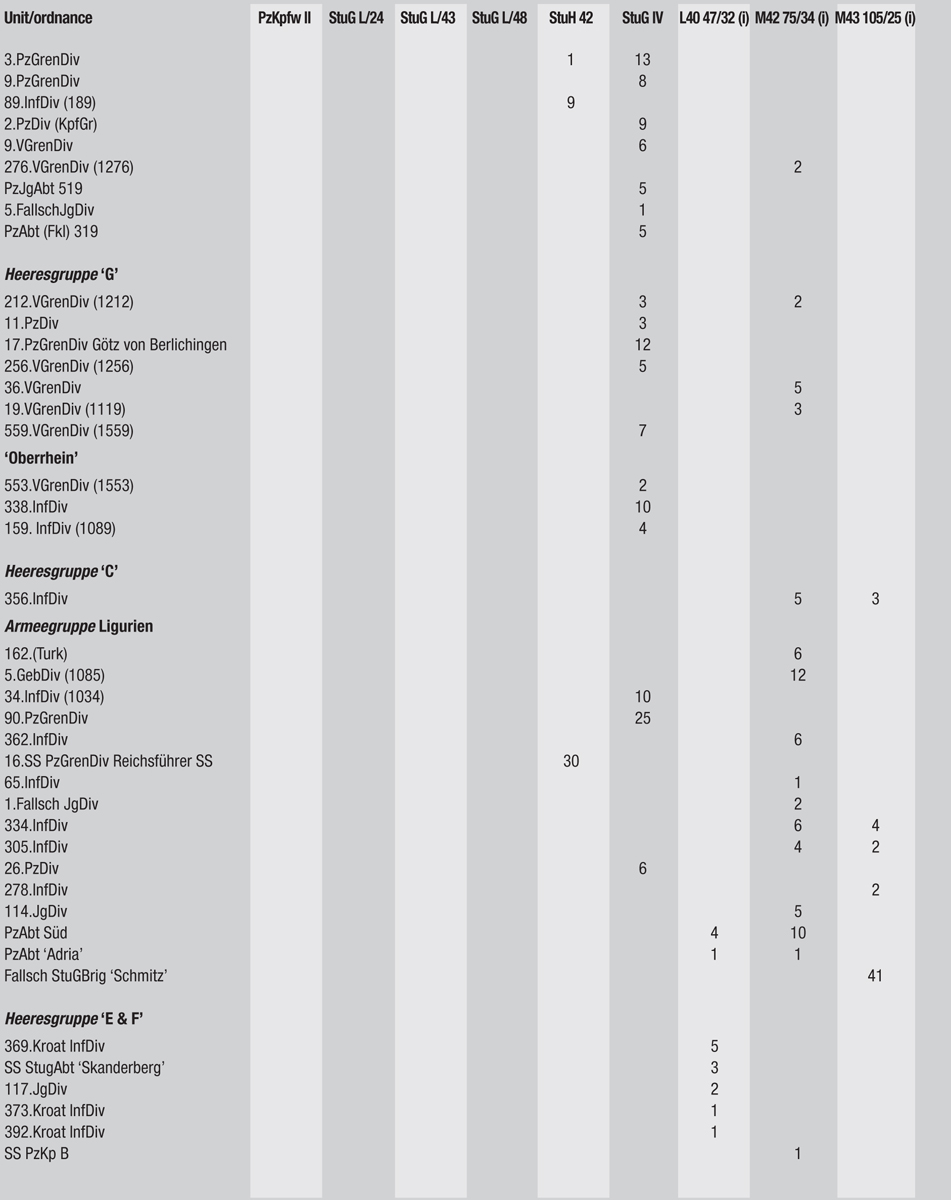
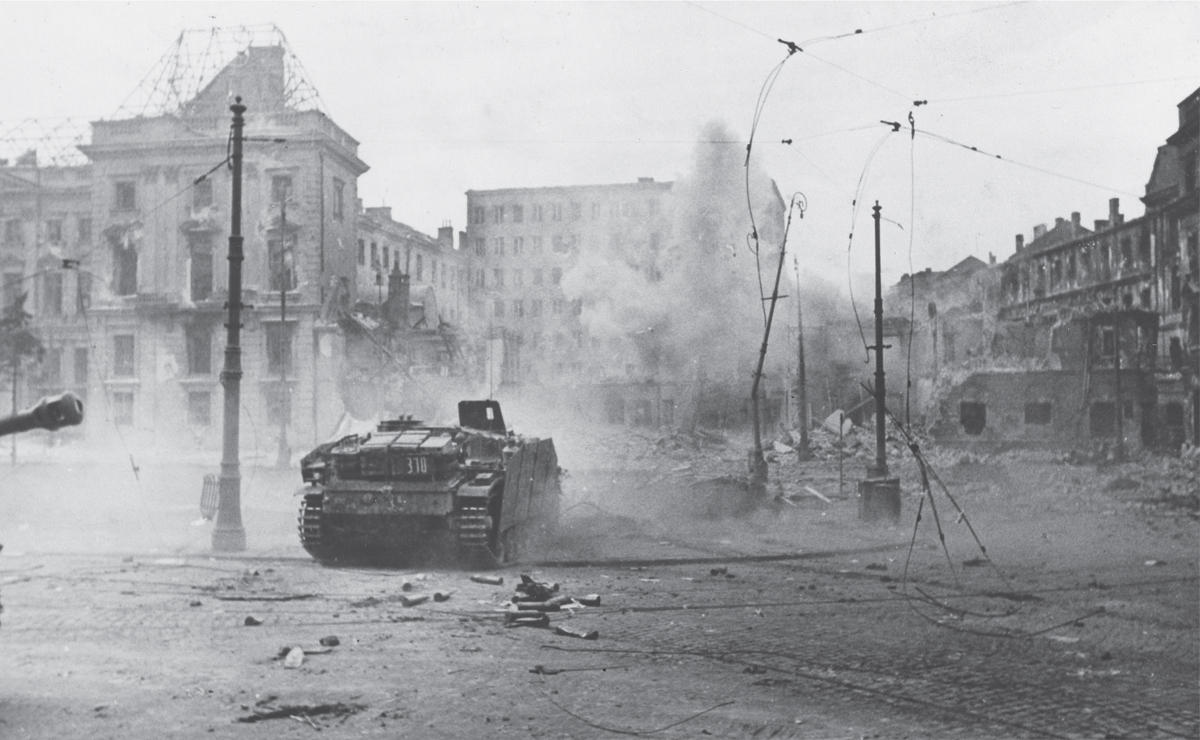
Warsaw in the summer of 1944: A Sturmgeschütz of PzAbt 302 (Fkl) fires on a building occupied by partisans. The pile of empty shell cases lays testimony to the fierce battles fought during the uprising. (Getty)
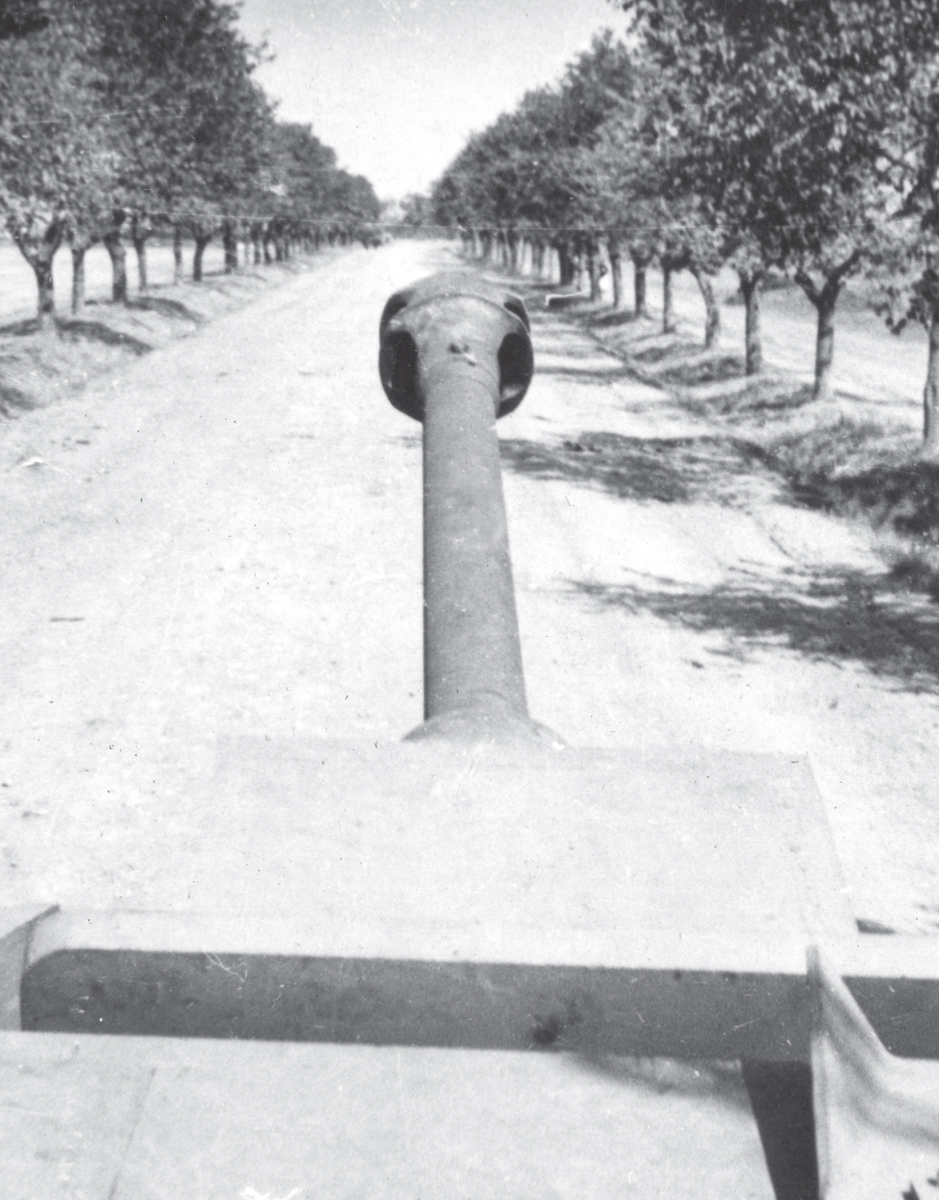
Developed as an answer to the Soviet T-34 and KV-1 tanks encountered in 1941, the 7.5cm StuK 40 L/48 became the standard ordnance for the Sturmgeschütz. This powerful weapon proved to be effective against all enemy tanks up until the war ended. (Anderson)